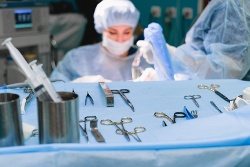Care professionals, the second victim of a medical incident

Table of contents

Whether it’s a tough conversation with only bad news or patients who are nearing the end and eventually pass away, care professionals are regularly confronted with the emotions of patients and their nearest and dearest. They have developed considerable experience with respect to how to handle emotion – and are accustomed to doing so. That is however not the case if the emotional cause can be attributed to a mistake made by themselves. Care professionals experience feelings of anxiety, uncertainty, shame and even loneliness. Naturally, the patients are the first victims of a medical incident, but the care professionals involved are victims too, the so-called second victims.
This blog describes the interventions that can be applied to support the care professionals involved. Most important is creating a healthcare safety culture, where people can talk openly about incidents.
Professor Albert Wu is an internist in the Johns Hopkins Hospital (1,000 beds, 2,000 medical specialists and 10,000 nursing staff) in the state of Maryland (USA). Professor Albert Wu drew international attention in the year 2000 to the second victim issue.
Attention has obviously been paid to healthcare incidents over the years, but only recently has it become unequivocally clear that a medical incident can have an enormous impact on care professionals too. It was Professor Albert Wu in the year 2000 who put the term second victim on the international agenda.
“Care professionals feel protracted anxiety after an incident, or display characteristics of post-traumatic stress.”
Second victim of a medical incident
Care professionals experience feelings of protracted anxiety after an incident and even show characteristics of a post-traumatic stress syndrome. Often, they quit their jobs, call in sick with burn-out complaints or suffer from suicidal tendencies for a prolonged period. There is no culture within hospitals where incidents or errors are openly discussed, although change is afoot: the awareness that it is important to organise help and assistance for second victims. Fortunately, most care professionals recover, although this process is beset with setbacks including sleeping problems, mood swings, concentration lapses, insecurity sentiments and compulsive incident repetition. Taken together, these symptoms result in a temporarily dysfunctional care professional, and this in itself can be hazardous for patient safety.
“Temporarily dysfunctional doctors are a risk to patient safety.”
The essence of creating a safety culture
Care professionals are often ashamed about the mistake made and become uncertain about the way they perform and even about their qualities. They are afraid of being reproached by patients or their bereaved nearest and dearest, and afraid of reputational damage to themselves, the department or the hospital. Not to mention potential grievance procedures and disciplinary cases.
The professional culture does not encourage open discussion of this matter and that can result in the care professional withdrawing into a shell of isolation. If there is no open culture (or Just Culture) within an organisation, colleagues can tend to ignore the care professional instead of rallying around him or her. As a consequence, the care professional withdraws yet further and suffers even more from second victim inclinations.
“It is not part of the professional culture to make mistakes, let alone talk about them or ask for help.”
Incident analysis
The sense of failure is reinforced by the fact that the origin of a calamity or incident in the healthcare sector is often attributed to human factors. In contrast to the aviation industry, where each and every incident is analysed right down to the finest details (technical components, for example). Expansive incident analysis can contribute to the determination of the root causes of the origin of the incident. It makes it clear that the cause of mistakes made often lies outside the scope of care professionals – and can be attributed more to the way in which healthcare is organised. Knowing this can reduce and even remove the sense of guilt experienced by the doctor due to the mistake made.
“Pointing the finger at a person is still a reflex. We name, blame and shame.”
Peer support by colleagues
Research in the United States indicates that care professionals caught up in a calamity need support. Only a small percentage actually receives this support from the organisation. Most of the care professionals say they would appreciate peer support, and not necessarily help from psychological or social workers. Although statistics are not readily available, there is no reason to believe that the situation in other countries is any different. Care professionals are unlikely to admit that they feel uncertain or unhappy after a serious error. The experience of a hospital in Groningen (The Netherlands) was that care professionals do not apply for support, and the specially-created Social Work department there had very little to do. This taught them that the best way to handle this kind of situation is through pro-active peer support.
“Most care professionals indicated they would like to receive peer support from a fellow care professional.”
For this reason, the hospital introduced Peer Support programmes in which specially-trained care professionals, nursing staff and paramedics help colleagues involved in a medical mistake and encourage them to share their experience. Every reported calamity is now accompanied by the name of those involved, so that they can be approached pro-actively for peer support.
What can we learn from this?
Thorough research with the help of the PRISMA method can contribute to the determination of the root causes of the origin of an incident. Deeper underlying causes are revealed. The question of guilt is less relevant, whereby a large part of the guilty feeling can be removed. Moreover, thorough research into the cause of incidents contributes to awareness. Care professionals learn to see that the way in which healthcare was organised in that specific incident can cause “human error”.
More information about PRISMA analysis? Click here for the blog: Every mistake is an opportunity to enhance healthcare safety.
During the calamity reporting process, pro-active peer support can prevent second victim inclinations. By recording on the report form the names of the care professionals involved, they can subsequently be actively approached with a peer support programme.
A safety culture or just culture, in which discussion about incidents is open and transparent, can reduce the heavy burden felt by care professionals who made a mistake. It can prevent isolation and promote the process of dealing with emotions.
Like to know more about interventions that you can apply to create culture change? Download the eBook 'Safety is our joint effort!' about creating a healthcare safety culture.
Related articles
-
 Patient safety Incident management Reporting data Quality management
Patient safety Incident management Reporting data Quality managementThe importance of incident reporting in nursing
Work accidents and incidents happen in every industry, including nursing. This article shows how reporting can help increase patient safety.
Read more -
 Patient safety Incident management Software Improve
Patient safety Incident management Software ImproveThe SIRE Method: A Specialized Version of Root Cause Analysis
Want to know more about the SIRE (Systematic Incident Reconstruction and Evaluation) method? Read all about this analysis method in this TPSC blog.
Read more -
 Patient safety Incident management Analyze & report
Patient safety Incident management Analyze & reportThe PRISMA Incident Analysis Method: Improving Patient Safety
Want to know more about the PRISMA Incident Analysis Method and how it is integrated in TPSC Cloud™? Read our blog and improve your patient safety!
Read more
